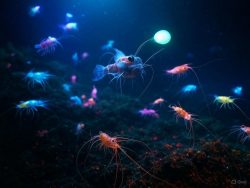The Glow of Life: How Infrared Signals Could Redefine Searching for Life On Other Planets
Posted By RichC on March 30, 2025
Over the weekend, a friend of mine sent me a link and asked for my thoughts on an article in the New Atlas, titled “Alien life might glow in the dark on infrared waterworld planets, says James Webb study” (published March 19, 2025). Perhaps even those of us who question the existence of “extraterrestrial life,” are still intrigued when unknown or new  scientific discoveries come to light.
scientific discoveries come to light.
The quest to find life beyond Earth has long captivated humanity, driving us to scan the cosmos for telltale signs of biology. Traditionally, this search has focused on biosignatures like oxygen, methane, or water vapor—chemical fingerprints familiar from our own planet. But a new study leveraging data from the James Webb Space Telescope (JWST) suggests we might need to broaden our perspective. According to researchers, alien life on water-rich exoplanets could emit a faint infrared glow, a phenomenon tied to bioluminescence. This intriguing possibility not only challenges our assumptions about what life looks like but also underscores the importance of embracing the unknown in our cosmic explorations.
Shortly before I was married, I took a bachelor camping trip with college friends to a less travelled shoreline area of North Carolina (photos from 1982 below). While sitting quietly on the beach at night, we were amazed at the beautiful glow of bioluminescence in the waves. Those who focus on ocean life know that many organisms, particularly those in the ocean’s depths, glow. From jellyfish to deep-sea fish, bioluminescence is a widespread survival strategy, used for communication, predation, or camouflage. The James Webb study posits that on exoplanets dominated by water—lacking the landmasses that shape Earth’s ecosystems—this trait could be even more prevalent. With no continents to break up their oceans, these “waterworlds” might host life that relies heavily on light to thrive in perpetual aquatic darkness. Crucially, the JWST’s infrared capabilities could detect this glow, offering a novel way to spot life where traditional biosignatures fall short.
in Holden Beach, NC waiting for the shrimp to boil (my bachelor trip 1982)
Logically, this idea holds water (pun intended). On Earth, bioluminescence is most common in environments where sunlight is scarce—think of the pitch-black trenches of the Pacific. A planet entirely submerged, with no surface exposed to starlight, could mimic those conditions across its entirety. Evolution might favor organisms that produce their own light, especially if their star emits less visible light and more infrared, as is true for the dim red dwarfs that dominate our galaxy. The JWST, with its unparalleled sensitivity to infrared wavelengths, is uniquely suited to catch such a signal, faint though it may be against the glare of a distant world.
Yet, this hypothesis invites scrutiny. Detecting infrared bioluminescence assumes it’s both widespread and intense enough to register across light-years. Earth’s glowing creatures, while numerous, emit light that’s feeble compared to planetary-scale phenomena like reflected starlight or thermal emissions. Scaling this up to a detectable exoplanet signature requires either an extraordinary density of bioluminescent life or some amplifying mechanism we haven’t yet grasped. The researchers acknowledge this, suggesting that microbial mats or vast plankton-like blooms could do the trick—plausible, but speculative without direct evidence.
Moreover, the focus on waterworlds raises questions about the diversity of life we’re willing to imagine. Liquid water is a prerequisite for life as we know it, but fixating on ocean planets risks blinding us to alternatives. Could life on a desert world, or one with exotic solvents like methane, also glow in ways we haven’t considered? The JWST’s infrared lens might reveal more than waterworlds—it could challenge us to rethink the boundaries of habitability altogether.
This study’s real strength lies in its willingness to pivot from the familiar. Oxygen and methane are Earth-centric markers, tied to our specific biochemistry. Bioluminescence, by contrast, is a behavior, not a molecule—a functional trait that could emerge from countless evolutionary paths. If alien life glows, it might not breathe oxygen or fart methane, yet still announce its presence in the infrared night. This shift from chemistry to phenomenology is a logical leap forward, urging us to prioritize observable outcomes over preconceived ingredients.
The implications ripple beyond science into philosophy. Finding a glowing planet wouldn’t just confirm life; it would force us to grapple with how alien that life might be. A waterworld aglow with infrared could host ecosystems so unlike Earth’s that our definitions of biology—let alone intelligence—would need rewriting. It’s a reminder that the universe doesn’t owe us familiarity. As we tune the JWST to these faint signals, we’re not just hunting for life; we’re testing our capacity to recognize it when it defies our mirror.
Of course, caution is warranted. A detected glow could stem from non-biological sources—mineral fluorescence, atmospheric chemistry, or instrumental noise. The study’s authors emphasize the need for rigorous follow-up, likely pairing JWST data with other observatories to rule out false positives. This is science at its best: bold in its hypotheses, disciplined in its proofs.
In the end, the idea of infrared-glowing waterworlds is less about certainty and more about possibility. It’s a call to expand our toolkit, to look beyond the obvious and embrace the strange. The JWST, peering into the universe’s infrared shadows, might just illuminate life in a way we never expected—not with a shout, but with a whisper of light. As we stand on the brink of such discoveries, one thing is clear: the search for alien life is as much about reimagining ourselves as it is about finding others.


Comments